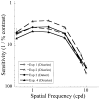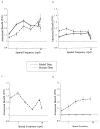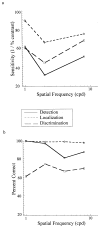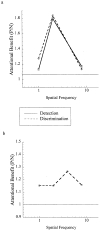Spatial covert attention increases contrast sensitivity across the CSF: support for signal enhancement
- PMID: 10788636
- PMCID: PMC3825514
- DOI: 10.1016/s0042-6989(00)00024-9
Spatial covert attention increases contrast sensitivity across the CSF: support for signal enhancement
Abstract
This study is the first to report the benefits of spatial covert attention on contrast sensitivity in a wide range of spatial frequencies when a target alone was presented in the absence of a local post-mask. We used a peripheral precue (a small circle indicating the target location) to explore the effects of covert spatial attention on contrast sensitivity as assessed by orientation discrimination (Experiments 1-4), detection (Experiments 2 and 3) and localization (Experiment 3) tasks. In all four experiments the target (a Gabor patch ranging in spatial frequency from 0.5 to 10 cpd) was presented alone in one of eight possible locations equidistant from fixation. Contrast sensitivity was consistently higher for peripherally- than for neutrally-cued trials, even though we eliminated variables (distracters, global masks, local masks, and location uncertainty) that are known to contribute to an external noise reduction explanation of attention. When observers were presented with vertical and horizontal Gabor patches an external noise reduction signal detection model accounted for the cueing benefit in a discrimination task (Experiment 1). However, such a model could not account for this benefit when location uncertainty was reduced, either by: (a) Increasing overall performance level (Experiment 2); (b) increasing stimulus contrast to enable fine discriminations of slightly tilted suprathreshold stimuli (Experiment 3); and (c) presenting a local post-mask (Experiment 4). Given that attentional benefits occurred under conditions that exclude all variables predicted by the external noise reduction model, these results support the signal enhancement model of attention.
Figures







References
-
- Balz GW, Hock HS. The effect of attentional spread on spatial resolution. Vision Research. 1997;37(11):1499–1510. - PubMed
-
- Bashinski HS, Bacharach VR. Enhancement of perceptual sensitivity as the result of selectively attending to spatial locations. Perception & Psychophysics. 1980;28:241–248. - PubMed
-
- Brainard DJ. The psychophysics toolbox. Spatial Vision. 1997;10:433–436. - PubMed
-
- Carrasco M, Penpeci-Talgar C. Attention affects orientation discrimination of Gabor patches of different frequencies. Investigative Ophthalmology and Visual Sciences (Suppl) 1999;40:806.
-
- Carrasco M, Penpeci C. Covert attention improves orientation discrimination across the contrast sensitivity function. Perception (Suppl) 1999;28:57A.
Publication types
MeSH terms
Grants and funding
LinkOut - more resources
Full Text Sources

